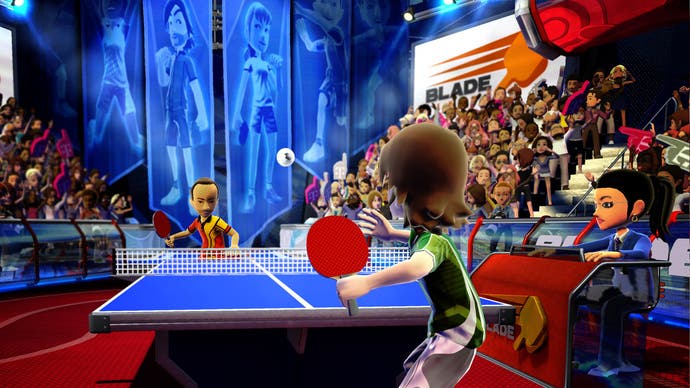The Case for Kinect
The strengths. The weaknesses. The facts. Digital Foundry investigates.
So if many of Kinect's limitations are software in nature and can be engineered, or "evolved" around, what of the hardware itself? Perhaps the biggest surprise - and disappointment - in viewing the final Kinect spec up against the PrimeSense reference camera is that the resolution of the all-important depth map has been reduced to just 25 per cent of its original size: 320x240 up against 640x480.
This makes the idea of tracking fingers, or any kind of fine detail, in a reliable fashion a complete non-starter, and so what you might call "higher level" interactions with games are going to be challenging to implement: there won't be any virtual keyboards to type on, for example: the precision simply isn't there. This leads on to another very simple question: if seated gameplay is implemented, just how are we expected to interact with the game if you can't use your fingers? Waving your arms about just won't cut it in many cases in terms of a full-fledged control system.
Bearing in mind the high hopes that Kinect would pave the way to the mythical Minority Report-style interface, it's ironic that the low-res depth map also seems to have led to one of the most immediately frustrating aspects of the Kinect experience: menu navigation and button selection is far less intuitive than hoped, and significantly slower than using a pad. A glowing orb or other pointer is moved about with your arm and you need to hold steady on your selection for a couple of seconds in order to activate it. Sony's Doctor Richard Marks - the architect of PlayStation Move - researched 3D cameras extensively before settling on the glowing wand design. We asked him what Kinect can do that the heavily hand- and finger-orientated Move cannot.
"Kinect has different data than we have. I'm really familiar with the data so I know exactly what it could do and yeah, sure it can do some things. It's really good for a certain slice of experiences like dancing or exercise, but it's hard to get out of a niche of experiences with it," Marks says.
"Having no buttons and no way to give information back easily... that's the limiting part I feel about it. The tech is still very interesting to us and to me and I'm still planning to explore things we could do with 3D input like that, but I just don't think it replaces what we have."


It's a fair comment of course, but perhaps the silver lining to the hardware limitations is that it forces developers to move away from control systems that are anything like those we currently use - innovation in control almost certainly brings about innovation in the overall gameplay concept. There's a strong argument that Kinect is able to forge its own identity with a line-up of wholly new games. As Marks says, there's absolutely no way that Kinect can replace Move, but it's good to have a very different choice which pushes developers to try something new: Child of Eden, anyone?
The range of titles revealed to date also poses a whole range of questions yet to be answered that have little to do with the tech and perhaps more to do with Microsoft's guidelines on how Kinect should be used.
Firstly, will Kinect be used to supplement input from the joypad in future core games? You would think that it would be a no-brainer, but thus far we have not seen a single title integrate the two control systems into one game. Indeed, the only thing even close to an announcement we've seen in that regard is with Fable III, which - curiously enough - has been stripped of its Kinect functionality. Secondly, there's no doubt that Kinect could be used to track player-held items, but why haven't we seen any game using them? How much cooler would a baseball game be if the game mapped an actual bat you're holding? The same principle applies to PGA Tour Golf too.
Just like the pad/Kinect hybrid, there is absolutely no reason why it couldn't be done from a technical standpoint, but you simply get the idea that Microsoft doesn't want it to happen in the here and now. Perhaps it would be somewhat at odds with the "you are the controller" marketing spin. Scanning of items via the RGB camera directly into the game is the closest we've seen yet to the idea of incorporating player-held items into the gameplay, and this is of course on message from a PR perspective.


There's a very definite sense that Kinect is a "walled garden" and that integration with core games isn't high on the agenda from Microsoft's perspective: it's all about new types of game (for 360, that is) for a new type of audience with very little cross-over with the hardcore. You can even see it in the pricing: a £130 price tag for the sensor alone might not seem so compelling, but at £249 for an HD console/sensor combo with support for multiple players has a lot more appeal, up against a single-controller standard def Wii SKU at £180.
Core gamers may well dismiss the majority of the Kinect line-up, but it's fair to say that many of us are equally dismissive of the likes of Wii Sports and Wii Fit - mega-selling game types that Nintendo is effectively monopolising. Microsoft reckon the "sci-fi" capabilities of Kinect can do these games better, and it's a space that Sony will have troubling competing in with Move, for exactly the reasons that Richard Marks pointed out earlier.
What it boils down to is a choice. In our view, PlayStation Move is the most flexible, versatile motion controller for either HD console. It's patently superior to Wii and indeed the MotionPlus upgrade. But as we've seen from the launch titles, the utilisation of the wand thus far falls way short of the superb concepts Sony is dreaming up in its R&D labs.
Kinect is something different and wholly removed from Move and the Wiimote. The fact that it's ideally suited to fitness and dance titles in a way that neither of the competing systems can match may well be enough on its own to guarantee success. However, in the longer term, it's the system's basic demand for innovation from developers that may well be the making of it.
